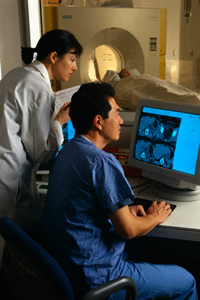
Visual/Multimedia Teaching In Pathophysiology
Overview
 "The use of technology and collaboration needs to be encouraged more than ever at the level of higher education, in order to prepare our students for the workplace. The worksite of business and industry is becoming ever more global, and people must become active questioners and investigators if they are to succeed. Thus, at the college/university level the role of the instructor needs to shift more and more from that of disseminator of information to that of facilitator of learning." "The use of technology and collaboration needs to be encouraged more than ever at the level of higher education, in order to prepare our students for the workplace. The worksite of business and industry is becoming ever more global, and people must become active questioners and investigators if they are to succeed. Thus, at the college/university level the role of the instructor needs to shift more and more from that of disseminator of information to that of facilitator of learning."
- Ben-Jacob, M. & Levin, D., 2000) .
.
Traditionally, images such as photographs or line drawings have been common in pathophysiology and health teaching. Obviously, anatomy, physiology and pathophysiology are much easier to understand if a visual representation of the topic is available. Only recently, since the very late 1990's, have multimedia and visual tools for teaching been available using the world wide web.
"The WWW is different from the other technologies in the distance ed toolset in one fundamental way: it is a comprehensive, "virtual" environment for delivering a wide variety of technologies which we are accustomed to thinking of as discrete, including text, still graphics, animation, audio, video (simple, low-end video), and (increasingly) interactive programming. The additional hypertext functionality of the WWW-which creates a linked or "webbed" environment instead of a linear one and permits easy and direct movement among related resources regardless of where in the world they are-provides substantial added value to WWW-based programming.
The WWW is a completely asynchronous environment accessible from any Internet-connected personal computer, providing a great deal of flexibility to the learner while maintaining easy, central management of the learning resource and straightforward, immediate correcting or updating of content. The WWW currently integrates at the personal computer level with other Internet resources including electronic mail, list servers, news groups, and "chat"; the WWW "browser" (primary access software) is incorporating access to these other Internet resources into its functionality and will in the future incorporate additional functionality, notably some form of desktop videoconferencing. It engages the learner and, by its very nature, encourages the use of learner-centered teaching strategies. The WWW is rapidly emerging as a universally-recognized environment for information management, education, entertainment, business and commerce, and many other uses,"
(Distance Education Strategies & Technologies Planning Team, 1996).
Another emerging medium for providing interactive teaching and coaching in prevention, chronic illness management and health promotion is the field of video games for health. Several of the top video design companies have recently turned their attention to applying the architecture and principles of designing entertainment based video games to the health education field. As well, some researchers and designers are beginning to offer web based games for health student patient education as well as therapeutic activities.
Ends in View
This learning activity is intended to give the learner the opportunity to:
1. Appreciate the positive benefits of using available online visual and multimedia tools in learning pathophysiology.
2. Develop search and research skills for finding appropriate multimedia resources on the world wide web.
3. Distinguish the unique qualities of visual and multisensory learning experiences in nursing education and practice.
In Preparation
1. READ: Future Bridge.(2020). Digital Pathology – Transforming the Future of Lab Testing
2. EXPLORE: the following visual and multimedia resource web sites for augmenting your education in physiology, health challenges and pathophysiology:
In Practice
1. As you move through the learning activities in your pathophysiology classes, augment your resources by searching for visual and other multimedia on the internet (use resources listed in the "In Preparation" section to start).
2. Keep track of the resources you use and compile them in a cohesive list in your wordprocessing program. Share your list with your classmates and instructor on a regular basis.
3. Participate in class discussion regarding the current available resources online that pertain to this course's content. Envision the ideal online resources. Share your vision with your classmates and instructor.
In Reflection
1. Do you feel that you learn pathophysiology and other course content easier when you use visuals and multimedia resources? Why?
2. What are the advantages and disadvantages of using internet materials in your coursework?
References
Ben-Jacob, M. & Levin, D. S. (2000). Collaborative Learning Networks: An Integral Component of The Educational Environment of the New Millennium. Available Online: WWW:
http://www.rcce.sc.edu/ssst/99proceedings.html
Distance Education Strategies & Technologies Planning Team. (1996). Teacgubg with Technologies at KU Medical Center
http://www.kumc.edu/de_strategies/final_report.html#changing
NEXT: SEMESTER 5 NURSING INFORMATICS LEARNING ACTIVITY.... . .
|